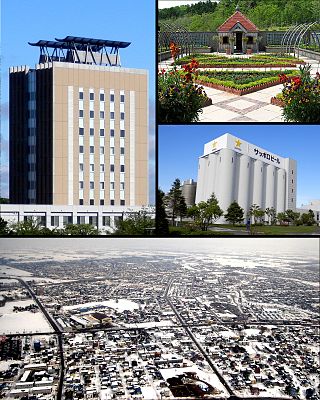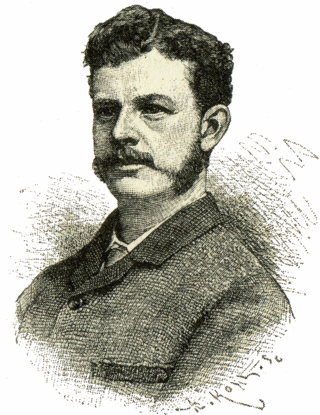
Hokkaido is Japan's second largest island and comprises the largest and northernmost prefecture, making up its own region. The Tsugaru Strait separates Hokkaidō from Honshu; the two islands are connected by the undersea railway Seikan Tunnel.

Eniwa is a city in Ishikari Subprefecture, Hokkaido, Japan. It is on the Ishikari plain, 8 km north of Chitose, and 26 km south of the prefectural capital Sapporo. It is reached through route 36 and the Chitose Railway Line. The town is separated into three major areas: Eniwa in the south, Megumino in the center, and Shimamatsu in the north.

William Smith Clark was an American professor of chemistry, botany, and zoology; a colonel during the American Civil War; and a leader in agricultural education. Raised and schooled in Easthampton, Massachusetts, Clark spent most of his adult life in Amherst, Massachusetts. He graduated from Amherst College in 1848 and obtained a doctorate in chemistry from Georgia Augusta University in Göttingen in 1852. He then served as professor of chemistry at Amherst College from 1852 to 1867. During the Civil War, he was granted leave from Amherst to serve with the 21st Regiment Massachusetts Volunteer Infantry, eventually achieving the rank of colonel and the command of that unit.

The Hokkaido wolf, also known as the Ezo wolf and in Russia as the Sakhalin wolf, is an extinct subspecies of gray wolf that once inhabited coastal north-east Asia. Its nearest relatives were the wolves of North America rather than Asia. It was exterminated in Hokkaido during the Meiji Restoration period, when American-style agricultural reforms incorporated the use of strychnine-laced baits to kill livestock predators. Some taxonomists believe that it survived up until 1945 on the island of Sakhalin. It was one of two subspecies that were once found in the Japanese archipelago, the other being the Japanese wolf.

Sapporo Breweries Ltd. is a Japanese beer brewing company founded in 1876. Sapporo is the oldest brand of beer in Japan. It was first brewed in Sapporo, Hokkaido, Japan, in 1876 by brewer Seibei Nakagawa. The world headquarters of Sapporo Breweries is in Ebisu, Shibuya, Tokyo. The company purchased the Canadian company Sleeman Breweries in 2006.

Hidaka Mountains is a mountain range in southeastern Hokkaido, Japan. It runs 150 km (93 mi) from Mount Sahoro or Karikachi Pass in central Hokkaidō south, running into the sea at Cape Erimo. It consists of folded mountains that range from 1,500 to 2,000 m in height. Mount Poroshiri is the highest at 2,053 m (6,736 ft). The Hidaka Mountains separate the subprefectures of Hidaka and Tokachi. Most of the range lies in the Hidaka-sanmyaku Erimo Quasi-National Park. Since the mountain range lies so far north, the alpine climate zone lies at a lower altitude.

Ulmus davidiana var. japonica, the Japanese elm, is one of the larger and more graceful Asiatic elms, endemic to much of continental northeast Asia and Japan, where it grows in swamp forest on young alluvial soils, although much of this habitat has now been lost to intensive rice cultivation.

Sapporo is a city in Japan. It is the largest city north of Tokyo and the largest city on Hokkaido, the northernmost main island of the country. It ranks as the fifth most populous city in Japan. It is the capital city of Hokkaido Prefecture and Ishikari Subprefecture. Sapporo lies in the southwest of Hokkaido, within the alluvial fan of the Toyohira River, which is a tributary stream of the Ishikari. It is considered the cultural, economic, and political center of Hokkaido.

The facilities of the former Hokkaidō Government Office in Sapporo, Japan, include a conference room, a museum shop, a tourist information office, and a few historical exhibition rooms and libraries. Visitors can enter the building for free. Flower gardens and a pond are located in front of the building, which occasionally are designated as some event venues.
7th Division was an infantry division in the Imperial Japanese Army. Its call-sign was the Bear Division.

Edwin Dun was a rancher from Ohio who was employed as an o-yatoi gaikokujin in Hokkaidō by the Hokkaidō Development Commission (Kaitakushi) and advised the Japanese government on modernizing agricultural techniques during the Meiji modernization period. He served as United States envoy to Japan from 1893 to 1897.

Horace Capron was an American businessman and agriculturalist, a founder of Laurel, Maryland, a Union officer in the American Civil War, the United States secretary of agriculture under U.S. presidents Andrew Johnson and Ulysses S. Grant, and an advisor to Japan's Hokkaidō Development Commission. His collection of Japanese art and artifacts was sold to the Smithsonian Institution after his death.
The wildlife of Japan includes its flora, fauna, and natural habitats. The islands of Japan stretch a long distance from north to south and cover a wide range of climatic zones. This results in a high diversity of wildlife despite Japan's isolation from the mainland of Asia. In the north of the country, north of Blakiston's Line, there are many subarctic species which have colonized Japan from the north. In the south there are south-east Asian species, typical of tropical regions. Between these areas lies the temperate zone which shares many species with China and Korea. Japan also has many endemic species that are found nowhere else in the world, making it home to many endangered/rare species.

Odori Park is a park located in the heart of Sapporo, Hokkaido, Japan. Ōdōri (大通) means "large street" in Japanese. It stretches east to west through Nishi 1 chōme, Ōdōri to Nishi 12 chōme, Ōdōri, and divides the city into north and south sections. Odori Park spans about 1.5 km and covers 78,901 m². During the urban planning of Sapporo, it was originally designated as the main street but it eventually became a park. Throughout the year, many events and ceremonies such as the Sapporo Lilac Festival and the Sapporo Snow Festival are held in the park, and local landmarks including the Sapporo TV Tower and the Sapporo City Archive Museum are located within its boundaries.

The Sapporo Beer Museum is a museum located in the Sapporo Garden Park in Higashi-ku, Sapporo, Hokkaidō, Japan. Registered as one of the Hokkaidō Heritage sites in 2004, the museum is the only beer museum in Japan. The red-brick building was erected originally as a factory of the Sapporo Sugar Company in 1890, and later opened as a museum in July 1987. The building also houses the Sapporo Beer Garden in the south wing.

The Sapporo Factory is a complex that includes a shopping mall, office, multiplex movie theaters, and museum, located in Chūō-ku, Sapporo, Hokkaidō, Japan. The building was formerly a brewery that belonged to the Kaitakushi, the old government of Hokkaidō prefecture, and later owned by the Sapporo Beer Company, the predecessor of the Sapporo Brewery. Currently, the Sapporo Factory is run by the Yebisu Garden Place, a subsidiary of Sapporo Holdings Ltd., and a real estate company. The original brewery building was built in 1876, and after the brewery ceased to function in beer production, the operations were moved to a new location in Eniwa, in 1993.

Charles Maries was an English botanist and plant collector who was sent by James Veitch & Sons of Chelsea, London to search for new hardy plants in Japan, China and Taiwan between 1877 and 1879; there he discovered over 500 new species, which Veitch introduced to England. Amongst his finds, several bear his name, including Abies mariesii, Davallia mariesii, Hydrangea macrophylla "Mariesii", Platycodon grandiflorus "Mariesii" and Viburnum plicatum "Mariesii".
The tondenhei were military settler colonists recruited after the Meiji Restoration to develop and defend Japan's northern frontier in Hokkaidō and Karafuto against foreign nations, particularly Imperial Russia. The first recruits in Japan were former samurai whose feudal lords had opposed the Meiji forces and whose domains were therefore abolished, leaving them without gainful employment. Later recruits included commoners as well as samurai.

The Hokkaidō Development Commission, sometimes referred to as Hokkaidō Colonization Office or simply Kaitakushi, was a government agency in early Meiji Japan. Tasked with the administration, economic development, and securing of the northern frontier in what, at the time of establishment, was known as Ezo, it was established in 1869 and disbanded in 1882.
















